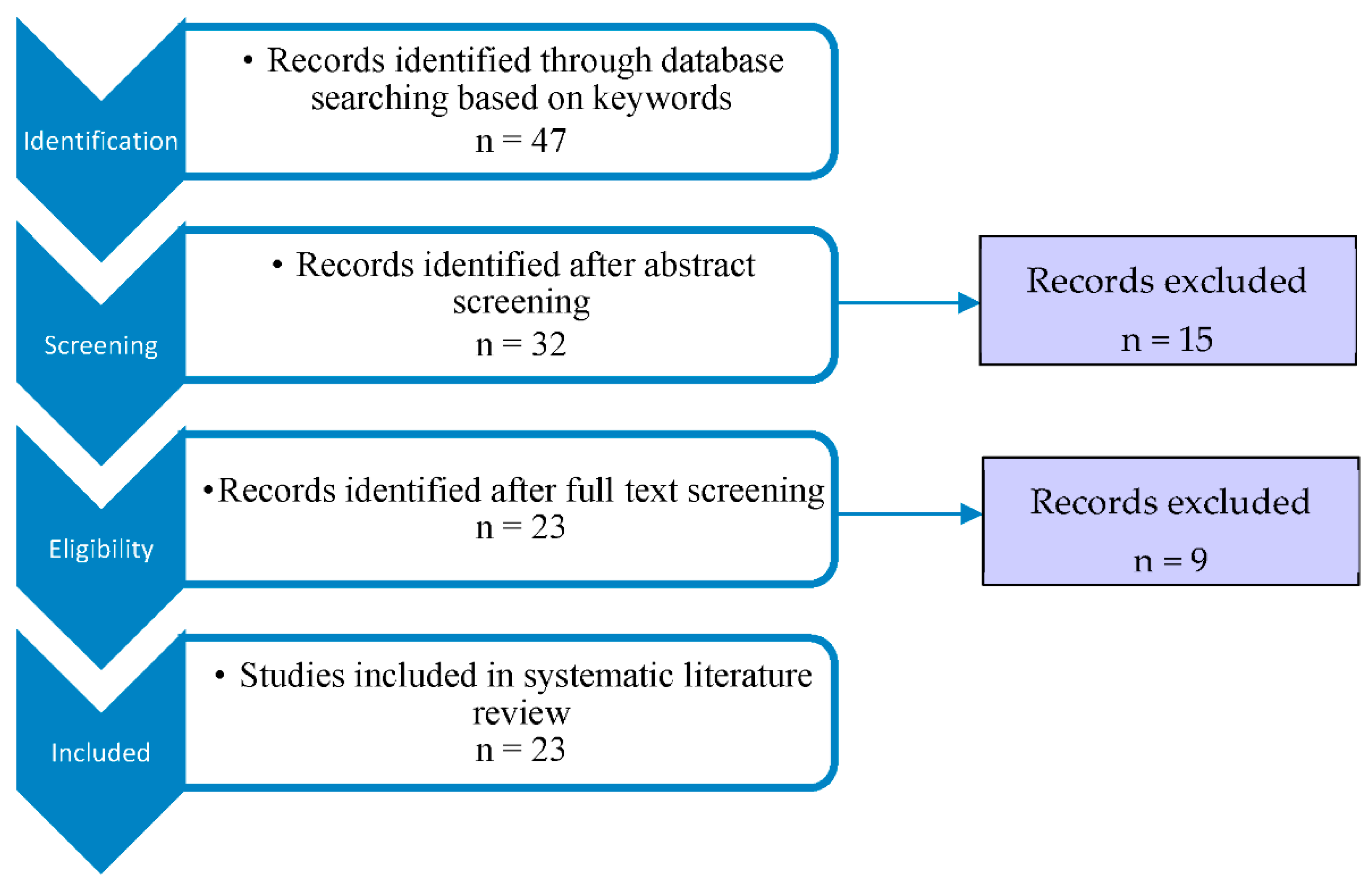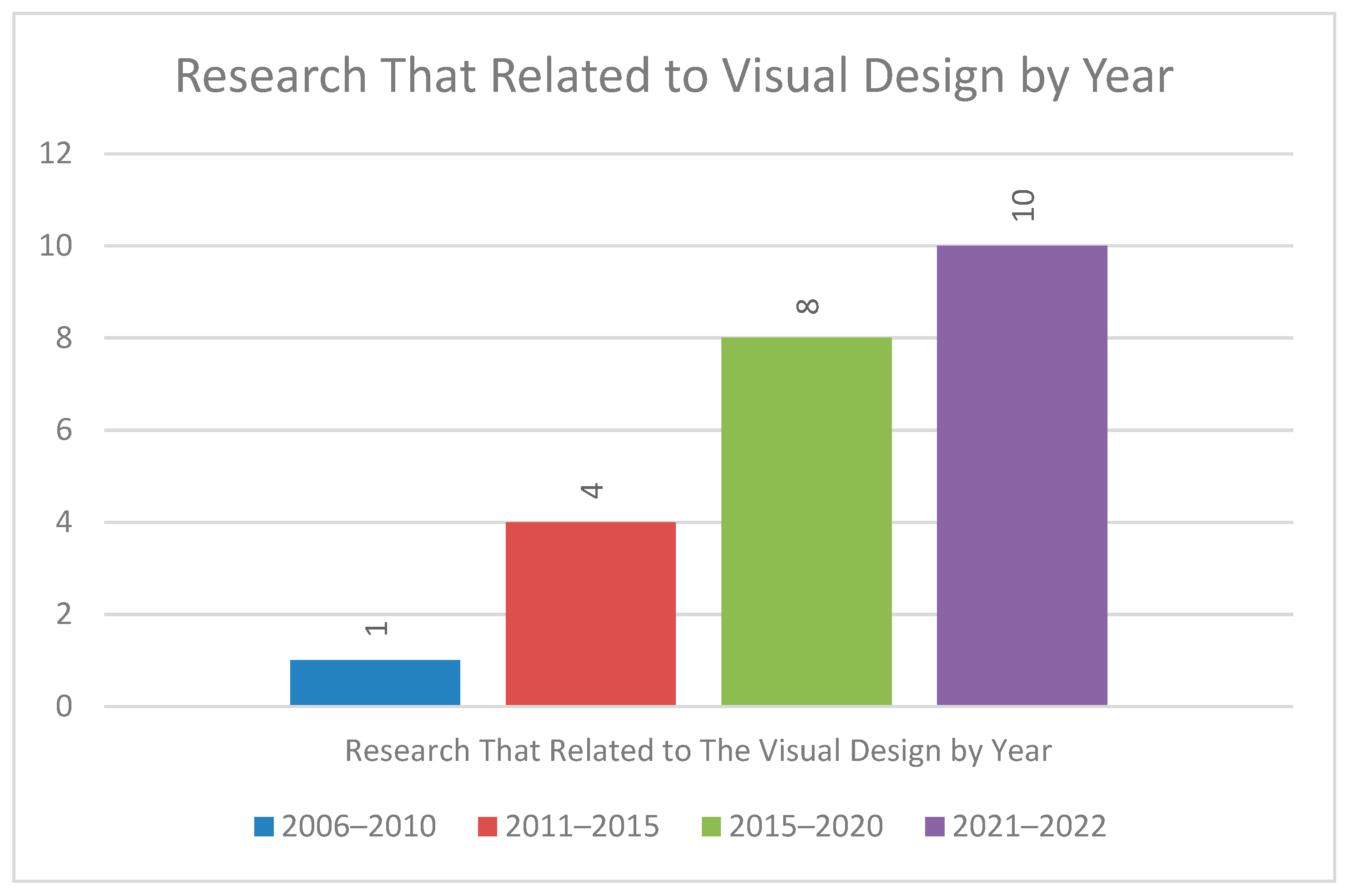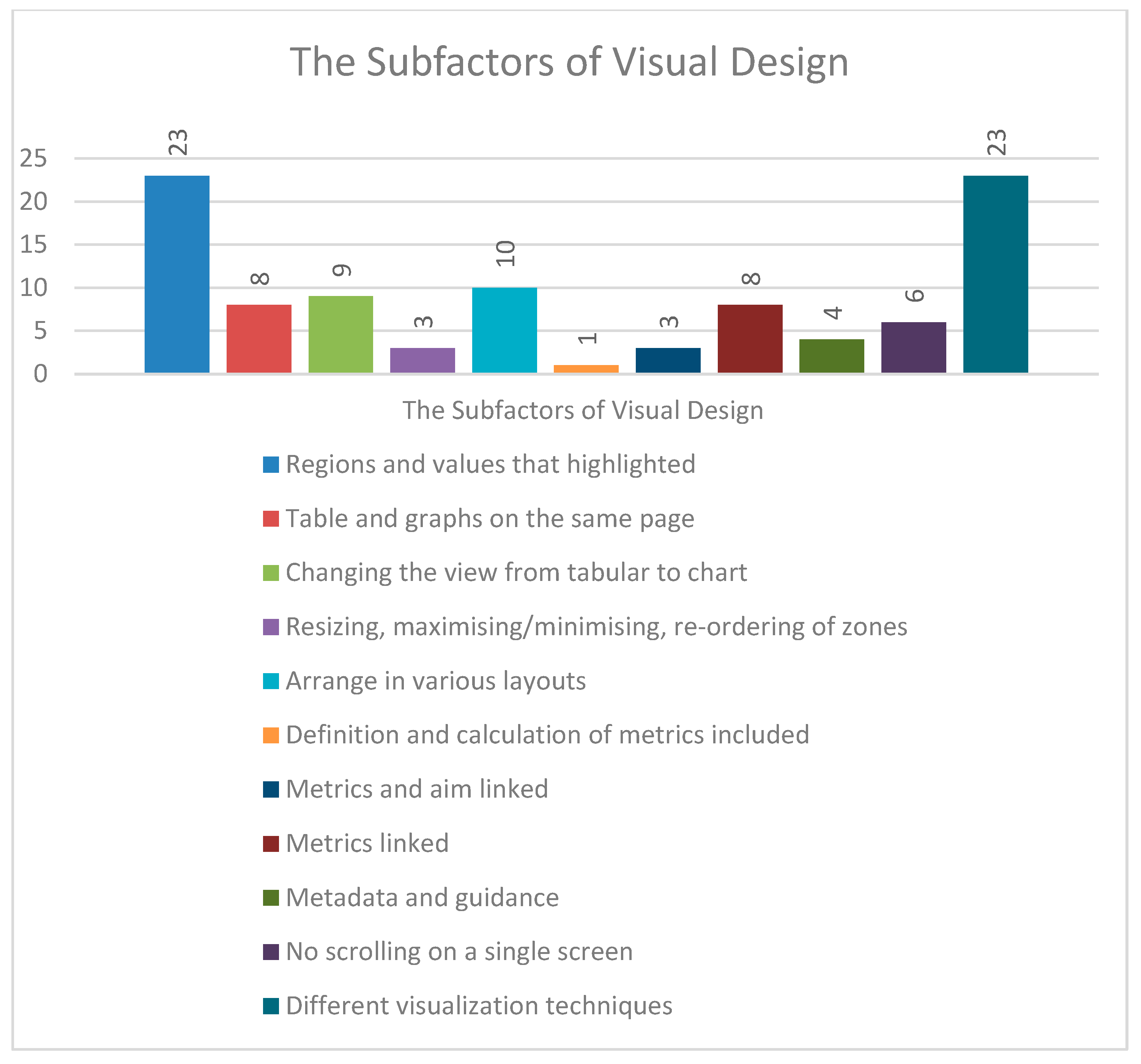Visual Design as the Key Factor for Effective Environmental Analytics Dashboard †
Abstract
1. Introduction
2. Methodology
3. Visual Design as the Key Factor
4. Discussion
5. Conclusions and Future Work
Author Contributions
Funding
Institutional Review Board Statement
Informed Consent Statement
Data Availability Statement
Conflicts of Interest
References
- Pappas, L.; Whitman, L. Riding the Technology Wave: Effective Dashboard Data Visualization. In Human Interface and the Management of Information. Interacting with Information; Springer: Berlin/Heidelberg, Germany, 2011; pp. 249–258. [Google Scholar] [CrossRef]
- Negash, S.; Gray, P. Business Intelligence. Handbook on Decision Support Systems. Int. Handbooks Inf. Syst. 2008, 2, 19–29. [Google Scholar]
- Yahya, F.; Zaki, A.F.A.; Moung, E.G.; Sallehudin, H.; Bakar, N.A.A.; Utomo, R.G. An IoT-Based Coastal Recreational Suitability System Using Effective Messaging Protocol. Int. J. Adv. Comput. Sci. Appl. 2021, 12, 558–567. [Google Scholar] [CrossRef]
- Janes, A.; Sillitti, A.; Succi, G. Effective Dashboard Design. Cut. IT J. 2013, 26, 17–24. [Google Scholar]
- Nadj, M.; Maedche, A.; Schieder, C. The Effect of Interactive Analytical Dashboard Features on Situation Awareness and Task Performance. Decis. Support Syst. 2020, 135, 113322. [Google Scholar] [CrossRef]
- Raheem, N. Big Data Visualization. In Big DataA Tutorial-Based Approach; Chapman and Hall/CRC: Boca Raton, FL, USA, 2019; pp. 75–102. [Google Scholar] [CrossRef]
- Bikakis, N. Big Data Visualization Tools. arXiv 2018, arXiv:1801.08336. [Google Scholar]
- Few, S. Information Dashboard Design; Eff. Vis. Commun. Data; O’Reilly Media, Inc.: Sebastopol, CA, USA, 2006; p. 37. [Google Scholar]
- Few, S. Dashboard Confusion. Available online: https://www.perceptualedge.com/articles/ie/dashboard_confusion.pdf (accessed on 21 June 2021).
- Baharum, A.; Wan, L.Y.; Yahya, F.; Nazlan, N.H.; Nor, N.A.M.; Ismail, I.; Noor, N.A.M. Mobile Learning Application: Flipped Classroom. Indones. J. Electr. Eng. Comput. Sci. 2020, 17, 1084–1090. [Google Scholar] [CrossRef][Green Version]
- Natalia, F.; Eko, Y.; Ferdinand, F.V.; Murwantara, I.M.; Ko, C.S. Interactive Dashboard of Flood Patterns Using Clustering Algorithms. ICIC Express Lett. Part B Appl. 2019, 10, 413–418. [Google Scholar] [CrossRef]
- Lee, D.; Felix, J.R.A.; He, S.; Offenhuber, D.; Ratti, C. CityEye: Real-Time Visual Dashboard for Managing Urban Services and Citizen Feedback Loops. In Proceedings of the 14th International Conference on Computing in Urban Planning and Urban Management (CUPUM), Cambridge, MA, USA, 7–10 July 2015. [Google Scholar]
- Malik, S.; Sharma, P. Dashboard Necessary in Every Field. Int. J. Comput. Sci. Inf. Technol. 2014, 5, 3511–3513. [Google Scholar]
- Karami, M.; Langarizadeh, M.; Fatehi, M. Evaluation of Effective Dashboards: Key Concepts and Criteria. Open Med. Inform. J. 2017, 11, 52–57. [Google Scholar] [CrossRef]
- Sarikaya, A.; Correll, M.; Bartram, L.; Tory, M.; Fisher, D. What Do We Talk about When We Talk about Dashboards? IEEE Trans. Vis. Comput. Graph. 2019, 25, 682–692. [Google Scholar] [CrossRef]
- Lempinen, H. Constructing a Design Framework for Performance Dashboards. In Nordic Contributions in IS Research; Springer: Berlin/Heidelberg, Germany, 2012; pp. 109–130. [Google Scholar]
- Abd-Elfattah, M.; Alghamdi, T.; Amer, E. Dashboard Technology Based Solution To Decision Making. Int. J. Comput. Sci. Eng. Inf. Technol. Res. 2014, 4, 59–70. [Google Scholar]
- Mayer, B.; Weinreich, R. A Dashboard for Microservice Monitoring and Management. In Proceedings of the 2017 IEEE International Conference on Software Architecture Workshops (ICSAW), Gothenburg, Sweden, 5–7 April 2017; pp. 66–69. [Google Scholar] [CrossRef]
- Dowding, D.; Merrill, J.A. The Development of Heuristics for Evaluation of Dashboard Visualizations. Appl. Clin. Inform. 2018, 9, 511–518. [Google Scholar] [CrossRef]
- Kamulegeya, G.; Mugwanya, R.; Hebig, R. Requirements for Measurement Dashboards and Their Benefits: A Study of Start-Ups in an Emerging Ecosystem. In Proceedings of the 2019 45th Euromicro Conference on Software Engineering and Advanced Applications (SEAA), Kallithea, Greece, 28–30 August 2019; pp. 300–308. [Google Scholar] [CrossRef]
- Harding, C. A User Analysis of the Environmental Finance Center’s Water and Wastewater Dashboard Tool. Master’s Thesis, University of North Carolina at Chapel Hill, Chapel Hill, NC, USA, 2021; 48p. [Google Scholar]
- Hehman, E.; Xie, S.Y. Doing Better Data Visualization. Adv. Methods Pract. Psychol. Sci. 2021, 4, 1–18. [Google Scholar] [CrossRef]
- Zhwan, M.; Khalid, S.R.M.Z. Big Data Analysis for Data Visualization: A Review. Int. J. Sci. Bus. 2021, 5, 64–75. [Google Scholar] [CrossRef]
- Bloemen, S. Designing a Dashboard Development Methodology for Heterogeneous Stakeholders in Dutch Nursing Homes. Master’s Thesis, University of Twente, Enschede, The Netherlands, 2022; pp. 1–40. [Google Scholar]
- Antonini, A.S.; Ganuza, M.L.; Castro, S.M. VISUEL—A Web Dynamic Dashboard for Data Visualization. J. Comput. Sci. Technol. 2022, 22, 42–57. [Google Scholar] [CrossRef]
- Khanbhai, M.; Symons, J.; Flott, K.; Harrison-White, S.; Spofforth, J.; Klaber, R.; Manton, D.; Darzi, A.; Mayer, E. Enriching the Value of Patient Experience Feedback: Web-Based Dashboard Development Using Co-Design and Heuristic Evaluation. JMIR Hum. Factors 2022, 9, 1–14. [Google Scholar] [CrossRef]
- Bach, B.; Freeman, E.; Abdul-Rahman, A.; Turkay, C.; Khan, S.; Fan, Y.; Chen, M. Dashboard Design Patterns. arXiv 2022, arXiv:2205.00757. [Google Scholar]
- Park, Y.; Jo, I.H. Factors That Affect the Success of Learning Analytics Dashboards. Educ. Technol. Res. Dev. 2019, 67, 1547–1571. [Google Scholar] [CrossRef]
- Jing, C.; Du, M.; Li, S.; Liu, S. Geospatial Dashboards for Monitoring Smart City Performance. Sustainability 2019, 11, 5648. [Google Scholar] [CrossRef]
- Deee, G.; Pack, M.L.; Young, S.; Ph, D.; Franz, M.L.; Pack, M.L.; Young, S. Transportation Energy Analytics Dashboard (TEAD). (No. DEEE0008465); 2021. Available online: https://www.osti.gov/biblio/1784082 (accessed on 21 June 2021).
- Wagh, S.J.; Bhende, M.S.; Thakare, A.D. Data Visualization Using Tableau. In Fundamentals of Data Science; Chapman and Hall/CRC: Boca Raton, FL, USA, 2021; pp. 249–267. [Google Scholar] [CrossRef]
- Bachechi, C.; Po, L.; Rollo, F. Big Data Analytics and Visualization in Traffic Monitoring. Big Data Res. 2022, 27, 100292. [Google Scholar] [CrossRef]
- Wimba, P.M.; Bazeboso, J.A.; Katchunga, P.B.; Tshilolo, L.; Longo-Mbenza, B.; Rabilloud, M.; Vanhems, P.; Iwaz, J.; Étard, J.F.; Écochard, R. A Dashboard for Monitoring Preventive Measures in Response to COVID-19 Outbreak in the Democratic Republic of Congo. Trop. Med. Health 2020, 48, 74. [Google Scholar] [CrossRef] [PubMed]




| Factors | Subfactors/Indicators | Sources/References |
|---|---|---|
| Visual design | Regions and values that highlighted | [1,4,7,8,14,15,16,17,18,19,20,21,22,23,24,25,26,27,28,29,30,31,32] |
| Table and graphs on the same page | [1,14,16,18,19,20,21,28] | |
| Changing the view from tabular to chart | [1,14,15,16,18,19,20,24,30] | |
| Resizing, maximising/minimising, re-ordering of zones | [1,14,19] | |
| Arrange in various layouts | [1,14,15,18,19,20,21,24,28,30] | |
| Definition and calculation of metrics included | [14] | |
| Metrics and aim linked | [1,8,14] | |
| Metrics linked | [1,7,14,15,18,21,22,30] | |
| Metadata and guidance | [4,14,21,28] | |
| No scrolling on a single screen | [1,8,14,16,18,28] | |
| Different visualisation techniques | [1,4,7,8,14,15,16,17,18,19,20,21,22,23,24,25,26,27,28,29,30,31,32] |
Publisher’s Note: MDPI stays neutral with regard to jurisdictional claims in published maps and institutional affiliations. |
© 2022 by the authors. Licensee MDPI, Basel, Switzerland. This article is an open access article distributed under the terms and conditions of the Creative Commons Attribution (CC BY) license (https://creativecommons.org/licenses/by/4.0/).
Share and Cite
Zainuddin, Z.; Yahya, F.; Yahya, A.F. Visual Design as the Key Factor for Effective Environmental Analytics Dashboard. Proceedings 2022, 82, 21. https://doi.org/10.3390/proceedings2022082021
Zainuddin Z, Yahya F, Yahya AF. Visual Design as the Key Factor for Effective Environmental Analytics Dashboard. Proceedings. 2022; 82(1):21. https://doi.org/10.3390/proceedings2022082021
Chicago/Turabian StyleZainuddin, Zada, Farashazillah Yahya, and Ahmad Fareez Yahya. 2022. "Visual Design as the Key Factor for Effective Environmental Analytics Dashboard" Proceedings 82, no. 1: 21. https://doi.org/10.3390/proceedings2022082021
APA StyleZainuddin, Z., Yahya, F., & Yahya, A. F. (2022). Visual Design as the Key Factor for Effective Environmental Analytics Dashboard. Proceedings, 82(1), 21. https://doi.org/10.3390/proceedings2022082021






